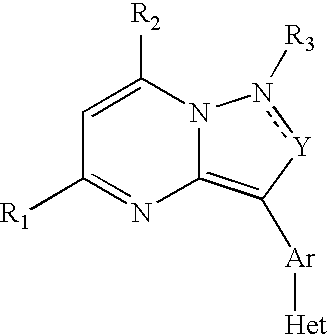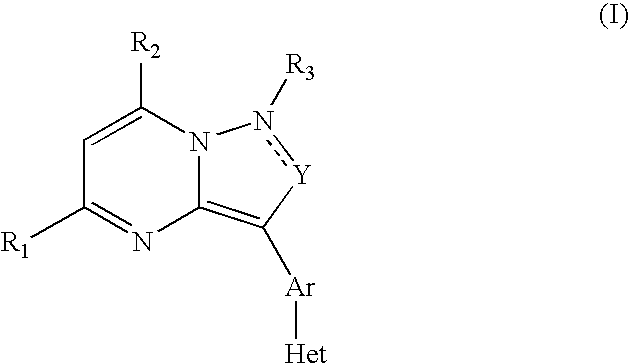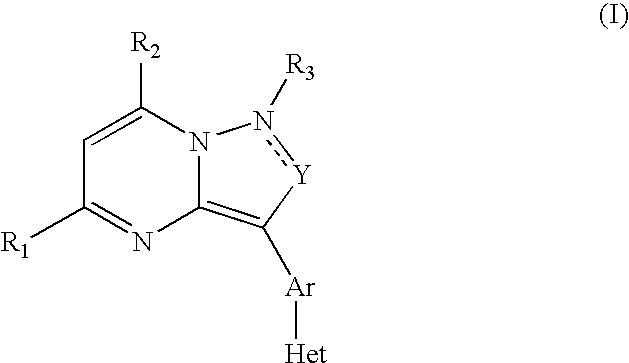Crf Receptor Antagonists and Methods
a technology of receptor antagonists and receptors, applied in the field of receptor antagonists, can solve the problems of lack of stability, limited oral activity, and sufferers of peptide crf receptor antagonists
- Summary
- Abstract
- Description
- Claims
- Application Information
AI Technical Summary
Benefits of technology
Problems solved by technology
Method used
Image
Examples
example 1
[0106]
Step 1A:
[0107] To a cooled suspension of methyl 4-amino-2-methoxybenzoate 1a (6.82 g, 37.7 mmol) in 6N HCl (aqueous) was added a solution of sodium nitrite (2.60 g, 37.7 mmol) dropwise. After stirring at 0° C. for 20 min, stannous chloride dihydrate (24.7 g, 109.3 mmol) was added portionwise. The resulting suspension was stirred at 0° C. for 1.5 h prior to filtration. The collected solid was suspended in EtOH to which malonaldehyde bis(dimethyl acetal) (7.5 mL, 45.7 mmol) was added, and this reaction mixture was subjected to reflux overnight. After evaporation of EtOH, the residue was extracted between EtOAc and water, and the organic phase was dried and evaporated to dryness. The residue was passed through a silica gel plug with 25% EtOAc / hexane to give compound 1b (7.43 g) as a mixture of methyl and ethyl benzoates.
Step 1B:
[0108] To a solution of 1b (10.6 g) in dry diethyl ether (200 mL) was added LAH powder (1.74 g) slowly at 0° C. After stirring for 45 min at 0° C. th...
example 2
[0113]
Step 2A:
[0114] In order to introduce hydrogen at position R4 of the invention, the synthetic scheme of Example 1 was modified at Step 1C to give the synthetic scheme of Example 2. To a solution of 1c (1.0 g) in HCO2Et (20 mL) was added metallic sodium (0.13 g) portionwise, and the mixture was refluxed for 1.5 h. The resulting suspension was decanted onto ice-water and acidified to pH 4.0. The organic phase was dried, evaporated to dryness, mixed with hydrazine monohydrobromide (1.58 g) and refluxed for 1 h in EtOH / H2O (6:1.) After evaporation of EtOH, the mixture was extracted between EtOAc and NaOH (aq.) The organic phase was dried and evaporated to dryness to yield compound 2a (1.20 g.)
Step 2B:
[0115] A mixture of 2a (1.2 g) was refluxed with ethyl acetoacetate (1.0 mL) in AcOH (30 mL) for 2 h. After evaporation of AcOH and precipitation in diethyl ether, compound 2b (1.0 g) obtained after filtration.
Step 2C:
[0116] To a suspension of 2b (1.0 g) in acetonitrile (30 mL)...
example 3
[0118]
Step 3A:
[0119] To a solution of 7-azainole (24 mg) in dry 1,4-dioxane was added NaH (12 mg) with stirring for 15 min. Compound 1f (35 mg) was added with stirring overnight. Preparative LC-MS purification gave compound 3-1 (6.1 mg.) Depending on the reacting amine, reaction of 1f with amine gave the compound(s) listed in the following table.
tRR2MWMS(method 4)3-1435.49435.81.601 (4)3-2412.50413.12.57 (1)
PUM
| Property | Measurement | Unit |
|---|---|---|
| Structure | aaaaa | aaaaa |
| Pharmaceutically acceptable | aaaaa | aaaaa |
| Disorder | aaaaa | aaaaa |
Abstract
Description
Claims
Application Information
 Login to View More
Login to View More - R&D
- Intellectual Property
- Life Sciences
- Materials
- Tech Scout
- Unparalleled Data Quality
- Higher Quality Content
- 60% Fewer Hallucinations
Browse by: Latest US Patents, China's latest patents, Technical Efficacy Thesaurus, Application Domain, Technology Topic, Popular Technical Reports.
© 2025 PatSnap. All rights reserved.Legal|Privacy policy|Modern Slavery Act Transparency Statement|Sitemap|About US| Contact US: help@patsnap.com



